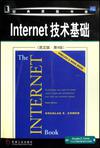Internet技术基础
2007-1
机械工业
Douglas E.Comer
无
DouglasComer是著名的网络技术作家、教师和顾问,他对因特网的概念和工作原理有其独到的见解和清晰的认识。在本书的第4版中,Comer教授从一种非技术化的角度来解释因特网后台的工作机制、计算机的通信方式、服务器以及因特网技术的原理。作者借助实用的方法,以清晰易懂且科学准确的语言介绍了因特网的各种技术及其不同的应用,向读者展示出网络互连和因特网的全景图。本书主要特色 •三大新增章节: NAT:介绍因特网的连接。 远程安全接入(VPN)。 公司和个人网页(Wiki及Blog)。 •关键网络概念,如分组交换、局域网、协议软件和域名。 •全新的内容,包括Wi-Fi的无线联网技术、Web制作工具,以及关于网络安全性的讨论。 •包括电子商务的概述以及如何利用网络进行业务和商业交易。 •采用更多易于理解的定义扩展了术语表的内容。
Douglas E. Comer Cisco公司研发副总裁,同时还是普度大学计算机科学系教授。他曾是因特网体系结构委员会的成员,该委员会确定因特网发展标准的权威结构;同时还是美国计算机学会的会员。除本书外,他还著有《TCP/IP网际互联》(3卷本)、《计算机网络和因特网》等。
PrefaceChapter 1 The Internet Has Arrived The World Has Changed Numbers Do Not Tell The Story Learning About The Internet Understanding The Big Picture Terminology And Technology Growth And Adaptability The Impact Of The Internet Organization Of The Book A Personal Note Chapter 2 Getting Started: Hands-On Experience Introduction The Web: Sites And Pages Web Browsers and Browsing Using A Browser Examples Of Web Sites And Services Internet Search Summary Chapter 3 Telephones Everywhere Introduction A Communication Service Selling Communication Limited Access High Cost The Difficult Transition Ubiquitous Access Relevance To The Internet Chapter 4 The World Was Once Analog Introduction Sound, Vibrations, And Analog Recording Analog Electronic Devices Many Electronic Devices Are Analog The First Analog Communication Analog Is Simple But Inaccurate Sending An Analog Signal Across A Wire Digital Music The Digital Revolution Computers Are Digital Digital Recording Using Digital To Recreate Analog Why Digital Music? SummaryChapter 5 The Once And Future Digital Network Introduction The World Was Previously Digital A Telegraph Is Digital Morse Code Letters And Digits In Morse Code Users Did Not Encounter Morse Code Virtually Instant Communication Speed Is Relative The Telephone Became Digital Relevance To The Internet Binary Encoding Of Data On The Internet Why Use Two Symbols? Summary Chapter 6 Basic Communication Introduction Communication Using Electricity Signals On Wires Information Coding Modems Allow Two-Way Traffic A Character Code For Digital Information Detecting Errors Summary Chapter 7 The Local Area Network Arrives Introduction Motivation Interchangeable Media A Computer Consists Of Circuit Boards Circuit Boards Plug Into A Computer Connecting One Computer To Another LAN Technologies Connecting A Computer To A LAN The Importance Of LAN Technology Relationship To The Internet PART II A Brief History Of The InternetChapter 8 Internet: The Early Years Many Independent Networks The Proliferation Of LANs Facts About LANs LANs Are Incompatible Wide Area Technologies Exist Few WANs, Many LANs WANs and LANs Are Incompatible The Desirability Of A Single Network The Department Of Defense Had Multiple Networks Connecting Disconnected Machines The Internet Emerges The ARPANET Backbone Internet Software The Name Is TCP/IP The Shock Of An Open System Open Systems Are Necessary TCP/IP Documentation Is Online The Military Adopts TCP/IP Summary A Personal Note Chapter 9 Two Decades Of Incredible Growth Introduction Disseminating The Software Meanwhile, Back In Computer Science The Internet Meets UNIX The U.S. Military Makes A Commitment The Internet Doubles In Size In One Year Every Computer Science Department Graduate Students Volunteer Their Time The IAB evolves The IETF Doubling Again In A Year The Internet Improves Science NSF Takes A Leadership Role Target: All Of Science And Engineering NSF’s Approach The NSFNET Backbone The ANS Backbone Exponential Growth A Commercial Assessment The End Of Growth Chapter 10 The Global Internet Introduction Early ARPA Netwos Electronic Mail Amng Computers BITNET And FIDONET Networks In Europe EBONE: The Internet In Europe Backbones And Internet Hierarchy Internet On All Continents The World Of Internet after 1998 A Personal Note Chapter 11 A Global Information InfrastructureChapter 12 Packet Switching Chapter 13 Internet: A Network Of Networks Chapter 14 ISPs: Broadband And Wireless Access Chapter 15 IP: Software To Create A Virtual Network Chapter 16 TCP: Software For Reliable Communication Chapter 17 Clients + Servers = Distributed ComputingChapter 18 Names For Computers Chapter 19 NAT: Sharing An Internet Connection Chapter 20 Why The Internet Works Well Chapter 21 Electronic Mail Chapter 22 Bulletin Board Service (Newsgroups) Chapter 23 Browsing The World Wide Web Chapter 24 World Wide Web Documents (HTML) Chapter 25 Advanced Web Technologies (Forms, Frames, Plugins, Java, JavaScript, Flash)Chapter 26 Group And Personal Web Pages (Wikis And Blogs) Chapter 27 Automated Web Search (Search Engines) Chapter 28 Text, Audio, And Video Communication (IM, VoIP) Chapter 29 Faxes, File Transfer, And File Sharing (FTP) Chapter 30 Remote Login And Remote Desktops (TELNET) Chapter 31 Facilities For Secure Communication Chapter 32 Secure Access From A Distance (VPNs) Chapter 33 Internet Economics And Electronic Commerce Chapter 34 The Global Digital Library Appendix 1 Glossary of Internet TermsIndex
书评“在可读性和清晰度方面,Douglas的表达力无出其右。本书的写作风格直接而且重点突出。……本书是适合网络初学者的一本优秀教材。” ——Raymond Hsieh,纽约州立大学布法罗分校 “本书以一种简洁的语言向学生介绍了因特网,指出了关键所在及未来发展方向。” ——RobinPeek,西蒙斯学院

无
书还行,是老师上课指定的教材,不是很厚,内容还行,涉及的方面比较多,也很杂,凑活着看
送达时书的质量不错。内容挺好的。